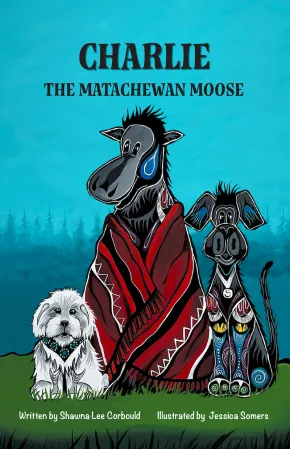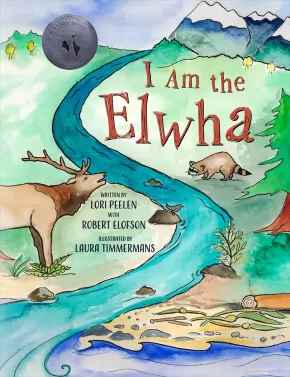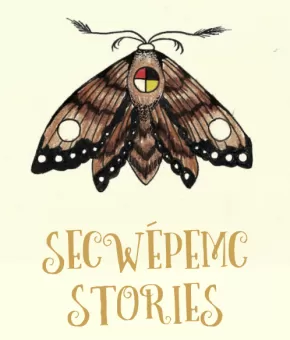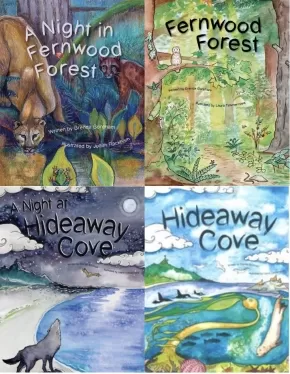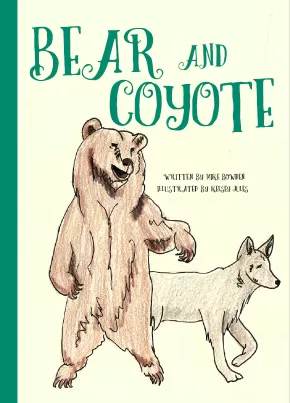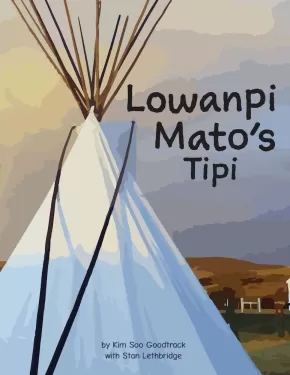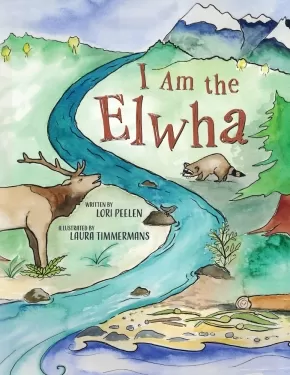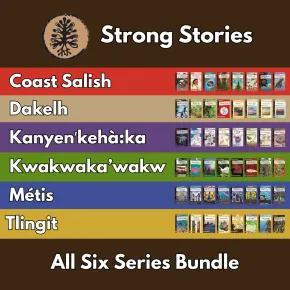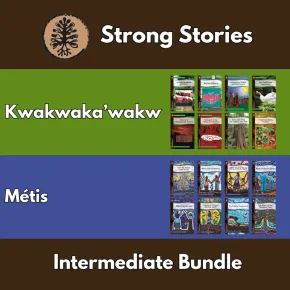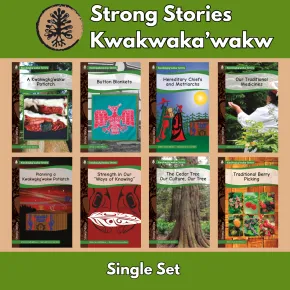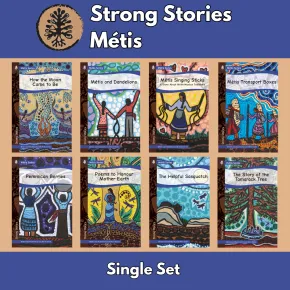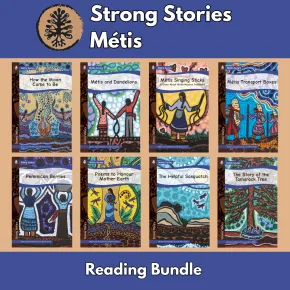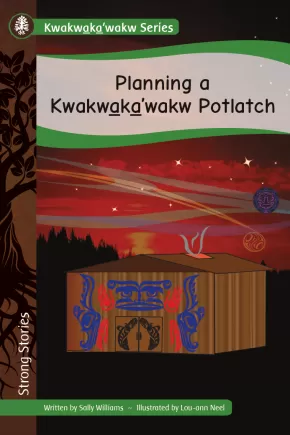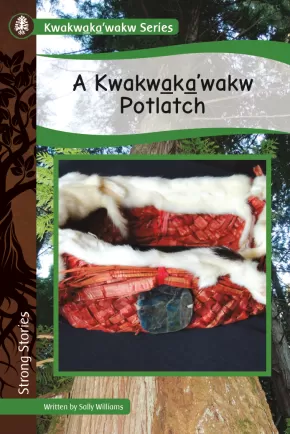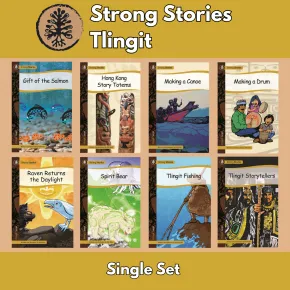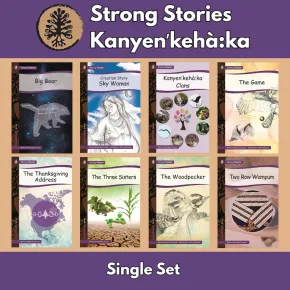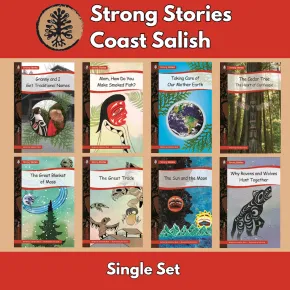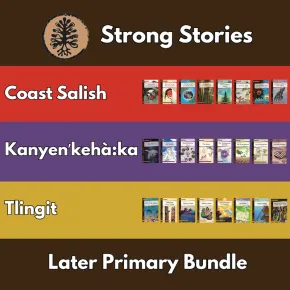
Grade 4
1
-
15
of
87 Results;
Sort By
Go To
of 6
Charlie the Matachewan Moose
 $14.95
$14.95

Artists:
Format:
Paperback
Text Content Territories:
Indigenous Canadian; First Nations; Anishinaabeg; Ojibway; Matachewan First Nation;
ISBN / Barcode: 9781771746342
Synopsis:
Synopsis:
There, in the middle of the forest, the young calf stood alone.
When a young moose calf gets lost in a storm, he is found by Nana and Papa, a kind couple who offer him shelter and a name: Charlie. They bring him home to Matachewan First Nation, where two dogs, Spike and Molly, happily welcome him into their pack. Together, Charlie and his friends spend their days digging holes on the beach, playing fetch, and having fun.
But Charlie is growing fast, and soon it will be time for him to return to the forest. With Spike and Molly by his side, Charlie sets off on an adventure to learn more about himself—and what it means to be a moose.
Educator Information
This illustrated chapter book is recommended for ages 6 to 9.
Flesch-Kincaid Grade Level: 2.9
The chapters are each titled with an Ojibwe word or phrase, and a glossary of the Ojibwe words and their pronunciations is included at the back of the book. Discussion questions and an author’s note can also be found at the end of the book, and a free lesson plan is available for download on our website.
With an engaging story, lovable characters, and powerful messages, Charlie the Matachewan Moose is perfect for readers transitioning from picture books to chapter books. Meaningful themes of identity and self-awareness provide opportunities for discussion, making this book an excellent choice for homes and classrooms.
Curriculum Connections
- English Language Arts – figures of speech, reading, listening, discussing
- Science – diverse ecosystems, animal behaviours and habitats
- Personal and Social Awareness – personal and cultural identity, connecting to community, identifying values
- Art – traditional Indigenous art styles
- Social-Emotional Learning – recognizing and managing emotions, building positive relationships, showing empathy
- Indigenous Knowledge and Traditions – Ojibwe language and teachings, cultural significance of animals
Additional Information
112 Pages | 5.5” x 8.5” | Paperback | Printed in Canada
I Am the Elwha (PB)
 $14.95
$14.95

Artists:
Format:
Paperback
Text Content Territories:
Indigenous American; Native American; Salish; Coast Salish; Klallam (Clallam); Lower Elwha Klallam Tribe;
ISBN / Barcode: 9781771746311
Synopsis:
Synopsis:
"I am the Elwha, rushing down to the sea. I am the Elwha, wild and free."
The Elwha River flows 72km (45 miles) from its source in the Olympic Mountains to the Strait of Juan de Fuca in the Pacific Northwest. Uniquely, it hosts all six salmon species (Pink, Chinook, Coho, Sockeye, Steelhead, and Chum) as well as several species of trout.
In 1911, two dams were built on the river. The dams blocked the migration routes of the salmon and dramatically altered the entire river ecosystem for 100 years. In 2012, the dams were decommissioned and the world's largest dam removal and habitat restoration project began. In this lyrical and beautifully illustrated book, the author chronicles the history of the Elwha.
Narrated by the powerful voices of plants and animals that inhabit the river ecosystem, the dam builder, a worker, members of the Klallam Tribe, and the river itself, this story celebrates the ongoing rewilding of this special environment and offers a welcome to all the creatures who are coming home.
To learn more visit: www.elwha.org
Awards
- 2021 Riverby Award for Young Readers
Reviews
“I Am the Elwha is a powerful read about a powerful river and those who value and protect it." – Raina Delisle, Hakai Magazine
Educator Information
Recommended for grades 3 to 7.
At the back of the book are three pages of cultural, scientific, and historical information that discuss the following:
- the importance and symbolism of salmon to the Lower Elwha Klallam Tribe and other Coastal Salish Tribes
- facts about the six species of salmon found in the Elwha River (Chinook, Pink, Chum, Sockeye, Coho, and Steelhead)
- the history of the Elwha River and its status today
Keywords / Subjects: The Elwha River, Rivers, Dams, History, Environmental Awareness, Lower Elwha Klallam Tribe, Coast Salish, Native American, Culture, Washington, Animals, Salmon, First Salmon Ceremony, Plants, Nature, Settlers, Social Responsibility, Environmental Activism, Poetry.
Additional Information
32 Pages | 8.5" x 11" | ISBN: 9781771746311 | Second Edition | Paperback
Authenticity Note: This lyrical story, which chronicles the history of the Elwha River, is written by Lori Peelen. Robert Elofson, Tribal Elder and Harvest Manager in the Natural Resources Department for the Lower Elwha Klallam Tribes, approved Lori's work and contributed pages of back matter at the end of the work. Lori's story was further approved by Frances Charles, the Tribal Councilwoman for the Lower Elwha Klallam Tribe, after the entire council read and approved it.
The Canadian Content label has been applied because the illustrator of this work is Canadian.
Secwépemc Stories Bundle
 $48.92 $54.35
$48.92 $54.35

Text Content Territories:
Indigenous Canadian; First Nations; Salish; Interior Salish; Secwepemc (Shuswap);
ISBN / Barcode: 9781771746632
Synopsis:
Synopsis:
This bundle includes all four Secwépemc stories from Mike Bowden:
- Four Winds (hardcover)
- Porcupine (paperback)
- Bear and Coyote (paperback)
- Chief Goose (paperback)
Secwépemc Stories are the collaborative work of Secwépemc author Mike Bowden and Secwépemc artist Kelsey Jules. These stories convey Secwépemc teachings and embody Indigenous ways of knowing. Mike, a storyteller and educator, strongly believes in story as a way of learning and understanding the world and our relationships within it. Secwépemc language is integrated into the stories and accompanied by pronunciation guides.
These stories connect to the BC First Peoples principles of learning and provide opportunities for those reading to reflect, explore, connect and learn on a personal interpretative level.
Additional Information
Books are 8.5" x 11" | 24 Pages | ISBN 9781771746632
Scroll below to learn more about each book included.
A Night in Fernwood Forest
 $21.95
$21.95

Artists:
Format:
Hardcover
ISBN / Barcode: 9781771746021
Synopsis:
Synopsis:
Come with us for a walk along a secluded forest trail on a quiet night in May. We catch glimpses of ten animals as they move about in their woodland home from dusk until dawn. A mother cougar and her cub, a colony of bats, and a family of shrews are among the nighttime creatures we encounter. Beautiful full-page illustrations also depict many plants that live in this ecosystem. Information at the back of the book provides facts about nurse logs and the Pacific Northwest temperate rainforest.
A Night in Fernwood Forest is part of the By Day and By Night Nature Series. Books in this series focus on a specific habitat and explore the many connections within a healthy ecosystem. Through lyrical stories, supportive illustrations, labelled diagrams, and nature notes, readers learn about living and non-living parts of the ecosystem.
Additionally, readers can:
- use a picture clue on each page to predict the animal featured on the next page
- count animals as their numbers increase in each illustration
- search for an animal that travels from page to page
- discover patterns in the text and structure of each book
- track the movement of the sun or moon across the sky
Reviews
"Brenda Boreham brings her teaching experience and love of nature to these books, filling them with opportunities for the discovery of interactions between plants and animals in healthy ecosystems…. This beautiful book will engage listeners and independent readers and support the science goals in elementary school classrooms." – Canadian Teacher Magazine, Winter 2024 issue
Educator & Series Information
Recommended for kindergarten to grade 4.
This is a fictional story with factual information about the Pacific Northwest temperate rainforest.
Search for a moth that travels from page to page in this story!
Each book in the By Day and By Night Nature Series focuses on a scene typical of a distinct west coast habitat, showing how living and non-living things are connected in a healthy ecosystem. As readers, we observe animals going about their daily activities: caring for their young, searching for food, and responding to the changes in light, temperature, and weather conditions throughout the day or night. The last four pages of each book provide facts about the highlighted animals and plants as well as features that are unique to their habitats. The final page suggests ways that young readers and their families can be respectful as they visit wilderness areas.
Readers with a sense of curiosity will find opportunities in these books to:
- use picture clues to predict the featured animal on the next page
- identify, count, and sequence numbers (1 owl, 2 deer, 3 squirrels, etc.)
- search for small creatures that travel from page to page
- discover patterns in the text and structure of the books
- track the movement of the sun, or moon, across the sky
Curriculum Links
Reading - Providing opportunities for guided practise in using reading strategies: visualizing, making connections, asking questions, transforming, and inferring.
Science - Supporting discussion and further exploration:
- characteristics of living things
- needs of living things
- connections between living and non-living things
- daily and seasonal changes
- animal growth and changes
- plant growth and changes
- weather
- habitats
- observable patterns in the sky
Numeracy - Counting and sequencing of numbers 1 to 10.
Social Responsibility - Initiating discussions about ways to take care of wilderness areas.
Additional Information
32 Pages | 8.5" x 11" | Hardcover | ISBN: 9781771746021
32 Pages | 8.5" x 11" | Hardcover | ISBN: 9781771746021
By Day and By Night Nature Series Bundle
 $72.32 $80.35
$72.32 $80.35

ISBN / Barcode: 9781771746014
Synopsis:
Synopsis:
This bundle includes all four titles in the By Day and By Night Nature Series:
- Hideaway Cove (hardcover)
- A Night at Hideaway Cove (paperback)
- Fernwood Forest (hardcover)
- A Night in Fernwood Forest (hardcover)
Each book in the By Day and By Night Nature Series focuses on a scene typical of a distinct west coast habitat, showing how living and non-living things are connected in a healthy ecosystem. As readers, we observe animals going about their daily activities: caring for their young, searching for food, and responding to the changes in light, temperature, and weather conditions throughout the day or night. The last four pages of each book provide facts about the highlighted animals and plants as well as features that are unique to their habitats. The final page suggests ways that young readers and their families can be respectful as they visit wilderness areas.
Readers with a sense of curiosity will find opportunities in these books to:
- use picture clues to predict the featured animal on the next page
- identify, count, and sequence numbers (1 owl, 2 deer, 3 squirrels, etc.)
- search for small creatures that travel from page to page
- discover patterns in the text and structure of the books
- track the movement of the sun, or moon, across the sky
Reading Level: Nonfiction text features such as headings, bold words, bullets, captions, and labelled diagrams make these books accessible to independent readers in grades 2 to 4. The books would also be great “read-alouds” for younger children.
Curriculum Links
Reading - Providing opportunities for guided practise in using reading strategies: visualizing, making connections, asking questions, transforming, and inferring.
Science - Supporting discussion and further exploration:
- characteristics of living things
- needs of living things
- connections between living and non-living things
- daily and seasonal changes
- animal growth and changes
- plant growth and changes
- weather
- habitats
- observable patterns in the sky
Numeracy - Counting and sequencing of numbers 1 to 10.
Social Responsibility - Initiating discussions about ways to take care of wilderness areas.
Lesson plans are available for each book and are free to download from each book's listing on our website!
Additional Information
Titles included are 32 pages, 8.5" x 11"
Please note: All books in this bundle are hardcovers, except for A Night at Hideaway Cove, which is a paperback as the hardcover edition is out of print.
Fernwood Forest
 $21.95
$21.95

Artists:
Format:
Hardcover
ISBN / Barcode: 9781771745994
Synopsis:
Synopsis:
Join us on a bright, sunlit day in the middle of May as we wander the quiet trails of a secluded woodland. Here, we catch glimpses of the daily activities of many creatures—from a pair of black-tailed deer to a colony of carpenter ants—that make Fernwood Forest their home. We also learn about the three layers of the Pacific Northwest temperate rainforest and explore interesting facts about forest plants and animals.
Fernwood Forest is part of the By Day and By Night Nature Series. Books in this series focus on a specific habitat and explore the many connections within a healthy ecosystem. Through lyrical stories, supportive illustrations, labelled diagrams, and nature notes, readers learn about living and non-living parts of the ecosystem.
Additionally, readers can:
-
use a picture clue on each page to predict the animal featured on the next page
-
count animals as their numbers increase in each illustration
-
search for an animal that travels from page to page
-
discover patterns in the text and structure of each book
-
track the movement of the sun or moon across the sky
Educator & Series Information
Recommended for kindergarten to grade 4.
This is a fictional story with factual information about the Pacific Northwest temperate rainforest.
Search for a bee that travels from page to page in this story!
Each book in the By Day and By Night Nature Series focuses on a scene typical of a distinct west coast habitat, showing how living and non-living things are connected in a healthy ecosystem. As readers, we observe animals going about their daily activities: caring for their young, searching for food, and responding to the changes in light, temperature, and weather conditions throughout the day or night. The last four pages of each book provide facts about the highlighted animals and plants as well as features that are unique to their habitats. The final page suggests ways that young readers and their families can be respectful as they visit wilderness areas.
Readers with a sense of curiosity will find opportunities in these books to:
- use picture clues to predict the featured animal on the next page
- identify, count, and sequence numbers (1 owl, 2 deer, 3 squirrels, etc.)
- search for small creatures that travel from page to page
- discover patterns in the text and structure of the books
- track the movement of the sun, or moon, across the sky
Curriculum Links
Reading - Providing opportunities for guided practise in using reading strategies: visualizing, making connections, asking questions, transforming, and inferring.
Science - Supporting discussion and further exploration:
- characteristics of living things
- needs of living things
- connections between living and non-living things
- daily and seasonal changes
- animal growth and changes
- plant growth and changes
- weather
- habitats
- observable patterns in the sky
Numeracy - Counting and sequencing of numbers 1 to 10.
Social Responsibility - Initiating discussions about ways to take care of wilderness areas.
Additional Information
32 Pages | 8.5" x 11" | Hardcover | ISBN: 9781771745994
32 Pages | 8.5" x 11" | Hardcover | ISBN: 9781771745994
Andy's Tribal Canoe Journey
 $21.95
$21.95

Artists:
Format:
Paperback
ISBN / Barcode: 9781771746007
Synopsis:
Synopsis:
Andy has had a rough school year and is ready for summer vacation. But when Grandpa Rick tells him that he will be participating in a canoe journey instead of enjoying his usual summer activities, Andy feels he is being punished.
Join Andy as he experiences a Tribal Canoe Journey for the first time and learns what it’s like to belong to a canoe family. Follow along as Andy navigates physical and emotional challenges and finds an answer to the important question: “Who am I?”
Awards
- 2024-2025 Hackmatack Children's Choice Award Shortlisted
Reviews
“Andy's Tribal Canoe Journey is a fantastic book to use for reading groups. We were able to have amazing discussions.… Students loved the pictures and the story. I hope to read this with as many students as possible.” – Holly Polischuk, Cayoosh Elementary School educator
"This graphic novel highlights how First Peoples connect to their culture and honour their past. The first-hand perspectives of participants in the 2019 journey help showcase the human emotions and physical challenges it involves. Teachers across elementary and secondary levels can use this short graphic novel as a read-aloud in a classroom or literature circles to help students learn about Tribal Canoe Journeys. Students could also be invited to explore their own traditions and experiences, and the art in the book could inspire projects that are based on the illustrations in this story." – Focused Education Resources
Educator Information
Recommended for grades 3 to 8.
Additional Information
72 Pages | 8" x 10" | Paperback | ISBN: 978-1-77174-600-7
Animals Care for Mother Earth: A Teaching Resource for Personal Development
$16.95
Artists:
Format:
Paperback
Text Content Territories:
Indigenous Canadian; First Nations; Tsimshian (Ts'msysen);
ISBN / Barcode: 9781771745970
Synopsis:
Synopsis:
Animals Care for Mother Earth comprises six contemporary, interrelated stories and supporting resources for teachers. In the first story, animals cooperate to clean up a polluted pond. In subsequent stories, they care for each other in the aftermath of the pollution problem, demonstrating strength of character and social responsibility. This book can be used in elementary schools to teach—through storytelling—the value of personal strengths and community supports while incorporating Tsimshian language and knowledge into classroom lessons. It also provides many opportunities to extend the learning to other curriculum areas, including science, math, reading, writing, social studies, and art.
Reviews
"This teaching resource uses storytelling as a way to impart knowledge and initiate discussions and activities that support social and emotional learning.” – Canadian Teacher Magazine, Spring 2023 issue
Educator Information
Recommended for use with grades 1 to 6 (elementary students).
Everything educators need is included in this single work -- contemporary Indigenous stories to read aloud and explore with students, as well as story guides, a map, plant information pages, suggestions for classroom activities, discussion questions, inquiry activities, talking together points, information to support intergenerational or peer-to-peer learning, and connections to the Core Competencies and social and emotional learning (SEL) competencies.
Find a bundle for Animals Care for Mother Earth that includes the book and learning environment resources HERE!
Additional Information
32 Pages | 8.5" x 11" | ISBN: 9781771745970 | Paperback
I Wish You Were Here
 $16.95
$16.95

Format:
Hardcover
Text Content Territories:
Indigenous Canadian; First Nations; Tsimshian (Ts'msysen); Haida;
ISBN / Barcode: 9781771745727
Synopsis:
Synopsis:
Dear Jean,
I had a substitute teacher recently. He stood up for a girl wearing a cedar hat when she was told to take it off by the vice-principal…
Even though Jean and Michael come from different cultural backgrounds and live far apart, they are best friends. To keep in touch, they write letters. Read their letters to discover what Jean and Michael do when they see and experience racial prejudice in their communities.
I Wish You Were Here is based on the authors' childhood experiences as pen pals in Haida Gwaii and Terrace in northern British Columbia. The book explores themes of friendship, culture, family, and community. It also addresses some tough issues, such as racism and intolerance, and explores ways to respond proactively. Included are resources and discussion questions to encourage further learning and reflection.
Reviews
“This lovely book explores healthy strategies for addressing racism and discrimination, including ceremonies, art, and intercultural allies. It is necessary reading for fostering the reconciliation and Indigenous resurgence that is imperative for our collective growth and enlightenment.” – Terri-Lynn Williams-Davidson, musician, author, activist, artist, and lawyer
“This book helps us to empower our children and each other in the important work of recognizing, talking about, and working through acts of racism.” – Severn Cullis-Suzuki, lifelong activist for intergenerational justice
Educator Information
Recommended for grades 3 to 7.
This middle-grade picture book includes discussion questions, a glossary, and additional resources for further learning and reflection.
Curriculum Connections & Keywords: Reconciliation, Indigenous Education, Social Awareness and Responsibility, Social Studies, Allyship, Racism, Anti-Racism, Discrimination, Social Justice, Racial Injustice, Haida, Haida Gwaii, Gwaii Haanas National Park, Tsimshian, Terrace, Letter Writing, Pen Pals, Friendship, Diversity, Child Empowerment, Advocacy, Inclusivity.
This book provides readers the opportunity to look at racism and discrimination through two different cultural lenses. It's a teaching tool to initiate conversations about issues such as racism, discrimination, and reconciliation.
In the video below, Erica Jean Reid Gidin Jaad shares how to pronounce Haida and Tsimshian words in I Wish You Were Here.
Additional Information
32 Pages | 6.5" x 9.5" | Hardcover | ISBN: 9781771745727
I Am Like a TREE Series Bundle
 $41.40 $46.00
$41.40 $46.00

Text Content Territories:
Indigenous Canadian;
ISBN / Barcode: 9781771745826
Synopsis:
Synopsis:
Included in this bundle are all four titles in the I Am Like a TREE series:
I Am Like a TREE: BARK and KNOTS – A Story of Courage and Struggles
I Am Like a TREE: LEAVES and BRANCHES – A Story of Belonging and Growth
I Am Like a TREE: SEEDS and LEAVES – A Story of Self Care and Belonging
I Am Like a TREE: TRUNK and ROOTS – A Story of Self and Empathy
The TREE in this series is a metaphor for what we are calling your “Present Self”. Our belief, through personal experience, is that we as living beings have several emotional parts that make us a whole, our Present Self. Each of these parts though are not equal in their emotional experience, so at times, different situations for an individual can be strong while at other times not. Some experiences can keep us in a frozen stage of development without knowing this and we then respond to “like type” experiences in the same way as we did in the past.
Our intention with these conversational stories in a reader’s theatre format is to provide a window into what emotional parts a person may use while having a conversation. The side margins tell all as each conversation unfolds indicating what parts of TREE the character is using. Some of these conversations are focused on the older individual trying to find a solution while the younger individual is providing support as best they can, as a solid TREE. Our intent is to imply that emotional learning is lifelong.
We hope that through these stories we will all continue to extend a hand to those who are reaching, listen to those who are speaking, and feel with an open heart to all those heartbeats that surround us. And for ourselves, love who you are, respect your own actions, and know that you deserve kindness, love and safety and that you belong here.
The back cover introduction and content overview inside make the books in the I Am Like a TREE series great for many learning situations. In each book are four discussion questions that focus on comprehension strategies and mental, physical, emotional, and spiritual connections. The books also provide an inquiry theme to explore and include five activity ideas for independent or group use.
Scroll below to learn more about each work included in this bundle.
Additional Information
ISBN: 9781771745826
I Am Like a TREE: BARK and KNOTS - A Story About Courage and Struggles
 $11.50
$11.50

Artists:
Format:
Paperback
Text Content Territories:
Indigenous Canadian;
ISBN / Barcode: 9781771745642
Synopsis:
Synopsis:
Conversations are important for everyone. Some conversations can only occur when we feel brave enough to say our words out loud. By talking with those who offer to listen and connect respectfully, we can grow emotionally. We can also learn ways to help others shine. By discovering, growing, and learning about the many emotional parts of ourselves and others, we can find our Present Self.
Follow along in this conversation that connects our emotional parts of ourselves to TREE (our Present Self). As BARK (Courage) and our KNOTS (Struggles) communicate, we learn that our parts grow inside of us so we can be just like a strong, healthy, and growing TREE.
Educator & Series Information
Recommended for Grades 4+
The back cover introduction and content overview inside make the books in the I Am Like a TREE series great for many learning situations. In each book are four discussion questions that focus on comprehension strategies and mental, physical, emotional, and spiritual connections. The books also provide an inquiry theme to explore and include five activity ideas for independent or group use.
This book is part of the social-emotional learning (SEL) series, I Am Like a TREE. I Am Like a TREE series consists of four titles:
I Am Like a TREE: BARK and KNOTS – A Story of Courage and Struggles
I Am Like a TREE: LEAVES and BRANCHES – A Story of Belonging and Growth
I Am Like a TREE: SEEDS and LEAVES – A Story of Self Care and Belonging
I Am Like a TREE: TRUNK and ROOTS – A Story of Self and Empathy
The TREE in this series is a metaphor for what we are calling your “Present Self”. Our belief, through personal experience, is that we as living beings have several emotional parts that make us a whole, our Present Self. Each of these parts though are not equal in their emotional experience, so, at times, different situations for an individual can be strong while at other times not. Some experiences can keep us in a frozen stage of development without knowing this and we then respond to “like type” experiences in the same way as we did in the past.
Our intention with these conversational stories in a reader’s theatre format is to provide a window into what emotional parts a person may use while having a conversation. The side margins tell all as each conversation unfolds indicating what parts of TREE the character is using. Some of these conversations are focused on the older individual trying to find a solution while the younger individual is providing support as best they can, as a solid TREE. Our intent is to imply that emotional learning is lifelong.
We hope that through these stories we will all continue to extend a hand to those who are reaching, listen to those who are speaking, and feel with an open heart to all those heartbeats that surround us. And for ourselves, love who you are, respect your own actions, and know that you deserve kindness, love and safety and that you belong here.
Additional Information
24 Pages | 8" x 8" | ISBN: 9781771745642 | Paperback
I Am Like a TREE: SEEDS and LEAVES - A Story About Survival and Belonging
 $11.50
$11.50

Artists:
Format:
Paperback
Text Content Territories:
Indigenous Canadian;
ISBN / Barcode: 9781771745635
Synopsis:
Synopsis:
Conversations are important for everyone. Some conversations can only occur when we have a sense of belonging. By talking with others, we can learn about healthy friendships and about ways to feel safe and protected. By discovering, growing, and learning about the many emotional parts of ourselves and others, we can find our Present Self.
Follow along in this conversation that connects our emotional parts of ourselves to TREE (our Present Self). As SEEDS (Self Care) and LEAVES (Belonging) communicate, we learn that our parts guide us so we can be just like a strong, healthy, and growing TREE.
Educator & Series Information
Recommended for Grades 4+
The back cover introduction and content overview inside make the books in the I Am Like a TREE series great for many learning situations. In each book are four discussion questions that focus on comprehension strategies and mental, physical, emotional, and spiritual connections. The books also provide an inquiry theme to explore and include five activity ideas for independent or group use.
This book is part of the social-emotional learning (SEL) series, I Am Like a TREE. I Am Like a TREE series consists of four titles:
I Am Like a TREE: BARK and KNOTS – A Story of Courage and Struggles
I Am Like a TREE: LEAVES and BRANCHES – A Story of Belonging and Growth
I Am Like a TREE: SEEDS and LEAVES – A Story of Self Care and Belonging
I Am Like a TREE: TRUNK and ROOTS – A Story of Self and Empathy
The TREE in this series is a metaphor for what we are calling your “Present Self”. Our belief, through personal experience, is that we as living beings have several emotional parts that make us a whole, our Present Self. Each of these parts though are not equal in their emotional experience, so, at times, different situations for an individual can be strong while at other times not. Some experiences can keep us in a frozen stage of development without knowing this and we then respond to “like type” experiences in the same way as we did in the past.
Our intention with these conversational stories in a reader’s theatre format is to provide a window into what emotional parts a person may use while having a conversation. The side margins tell all as each conversation unfolds indicating what parts of TREE the character is using. Some of these conversations are focused on the older individual trying to find a solution while the younger individual is providing support as best they can, as a solid TREE. Our intent is to imply that emotional learning is lifelong.
We hope that through these stories we will all continue to extend a hand to those who are reaching, listen to those who are speaking, and feel with an open heart to all those heartbeats that surround us. And for ourselves, love who you are, respect your own actions, and know that you deserve kindness, love and safety and that you belong here.
Additional Information
24 Pages | 8" x 8" | ISBN: 9781771745635 | Paperback
I Am Like a TREE: LEAVES and BRANCHES - A Story of Belonging and Growth
 $11.50
$11.50

Artists:
Format:
Paperback
Text Content Territories:
Indigenous Canadian;
ISBN / Barcode: 9781771745628
Synopsis:
Synopsis:
Conversations are important for everyone. Some conversations can only occur when we feel understood. By talking with others, we can learn new ways to be respectful, kind, and empathetic. As we deepen our learning, we become more aware of our own actions. By discovering, growing, and learning about the many emotional parts of ourselves and others, we can find our Present Self.
Follow along in this conversation that connects our emotional parts of ourselves to TREE (our Present Self). As LEAVES (Belonging) and BRANCHES (Growth) communicate, we learn that our parts protect us so we can be just like a strong, healthy, and growing TREE.
Educator & Series Information
Recommended for Grades 4+
The back cover introduction and content overview inside make the books in the I Am Like a TREE series great for many learning situations. In each book are four discussion questions that focus on comprehension strategies and mental, physical, emotional, and spiritual connections. The books also provide an inquiry theme to explore and include five activity ideas for independent or group use.
This book is part of the social-emotional learning (SEL) series, I Am Like a TREE. I Am Like a TREE series consists of four titles:
I Am Like a TREE: BARK and KNOTS – A Story of Courage and Struggles
I Am Like a TREE: LEAVES and BRANCHES – A Story of Belonging and Growth
I Am Like a TREE: SEEDS and LEAVES – A Story of Self Care and Belonging
I Am Like a TREE: TRUNK and ROOTS – A Story of Self and Empathy
The TREE in this series is a metaphor for what we are calling your “Present Self”. Our belief, through personal experience, is that we as living beings have several emotional parts that make us a whole, our Present Self. Each of these parts though are not equal in their emotional experience, so, at times, different situations for an individual can be strong while at other times not. Some experiences can keep us in a frozen stage of development without knowing this and we then respond to “like type” experiences in the same way as we did in the past.
Our intention with these conversational stories in a reader’s theatre format is to provide a window into what emotional parts a person may use while having a conversation. The side margins tell all as each conversation unfolds indicating what parts of TREE the character is using. Some of these conversations are focused on the older individual trying to find a solution while the younger individual is providing support as best they can, as a solid TREE. Our intent is to imply that emotional learning is lifelong.
We hope that through these stories we will all continue to extend a hand to those who are reaching, listen to those who are speaking, and feel with an open heart to all those heartbeats that surround us. And for ourselves, love who you are, respect your own actions, and know that you deserve kindness, love and safety and that you belong here.
Additional Information
24 Pages | 8" x 8" | ISBN: 9781771745628 | Paperback
I Am Like a TREE: TRUNK and ROOTS - A Story of Self and Empathy
 $11.50
$11.50

Artists:
Format:
Paperback
Text Content Territories:
Indigenous Canadian;
ISBN / Barcode: 9781771745611
Synopsis:
Synopsis:
Conversations are important for everyone. Some conversations can only occur when we feel understood. By talking with others, we can learn new ways to be respectful, kind, and empathetic. As we deepen our learning, we become more aware of our own actions. By discovering, growing, and learning about the many emotional parts of ourselves and others, we can find our Present Self.
Follow along in this conversation that connects our emotional parts of ourselves to TREE (our Present Self). As TRUNK (Self) and ROOTS (Empathy) communicate, we learn that our parts interconnect so we can be just like a strong, healthy, and growing TREE.
Educator & Series Information
Recommended for Grades 4+
The back cover introduction and content overview inside make the books in the I Am Like a TREE series great for many learning situations. In each book are four discussion questions that focus on comprehension strategies and mental, physical, emotional, and spiritual connections. The books also provide an inquiry theme to explore and include five activity ideas for independent or group use.
This book is part of the social-emotional learning (SEL) series, I Am Like a TREE. I Am Like a TREE series consists of four titles:
I Am Like a TREE: BARK and KNOTS – A Story of Courage and Struggles
I Am Like a TREE: LEAVES and BRANCHES – A Story of Belonging and Growth
I Am Like a TREE: SEEDS and LEAVES – A Story of Self Care and Belonging
I Am Like a TREE: TRUNK and ROOTS – A Story of Self and Empathy
The TREE in this series is a metaphor for what we are calling your “Present Self”. Our belief, through personal experience, is that we as living beings have several emotional parts that make us a whole, our Present Self. Each of these parts though are not equal in their emotional experience, so, at times, different situations for an individual can be strong while at other times not. Some experiences can keep us in a frozen stage of development without knowing this and we then respond to “like type” experiences in the same way as we did in the past.
Our intention with these conversational stories in a reader’s theatre format is to provide a window into what emotional parts a person may use while having a conversation. The side margins tell all as each conversation unfolds indicating what parts of TREE the character is using. Some of these conversations are focused on the older individual trying to find a solution while the younger individual is providing support as best they can, as a solid TREE. Our intent is to imply that emotional learning is lifelong.
We hope that through these stories we will all continue to extend a hand to those who are reaching, listen to those who are speaking, and feel with an open heart to all those heartbeats that surround us. And for ourselves, love who you are, respect your own actions, and know that you deserve kindness, love and safety and that you belong here.
Additional Information
24 Pages | 8" x 8" | ISBN: 9781771745611 | Paperback
Porcupine (PB)
 $11.95
$11.95

Artists:
Format:
Paperback
Text Content Territories:
Indigenous Canadian; First Nations; Salish; Interior Salish; Secwepemc (Shuswap);
ISBN / Barcode: 9781771745710
Synopsis:
Synopsis:
Kú7pece (Porcupine) has always struggled with his emotions and pushed his relations away. Kú7pece does not like this part of himself and wants to explore his identity and learn more about himself, his family, and the land.
To connect with his relations and his friends, Kú7pece decides to build a gathering place: a c7ístkten̓ (winter home). This is a place he is hoping his relations can gather and learn about each other through sharing stories. However, Kú7pece traps the sun and soon gets distracted by the sun’s heat and light. So much so, he forgets who he is and his purpose. Soon he is trapped too and cannot see that he is neglecting his responsibilities.
It takes the sacrifice of his relations and friends to help him realize he was trapped in his own reality. Once he realizes the lesson of the sacrifice of his friends – that they were trying to help him reconnect to his own place and purpose – he uses all his courage to turn away from the sun’s heat and light. Slowly, he remembers his identity, purpose, and responsibilities. In the end, Kú7pece finds himself again and reconnects with his relations to gather to tell stories, learn from each other, and support one another.
Porcupine is a story about expressing emotions and being considerate to the needs of others. It works well as a bedtime story or read-aloud for classrooms.
This book works well with others by Mike Bowden and Kelsey Jules, including Four Winds, Bear and Coyote, and Chief Goose.
Educator Information
Recommended for grades 3 to 7.
This book is part of the Secwépemc Stories series.
This story is a great resource to introduce Indigenous languages to young readers. Secwepemctsín is one of 30 distinct Indigenous languages in British Columbia and is in the process of being revitalized after governments and religions developed policies to eliminate the rich language and culture of Indigenous peoples. The book integrates Secwépemc words into the text and includes a pronunciation guide on every page.
This story connects to the BC First Peoples’ Principles of Learning: learning is holistic, reflexive, experiential, and relational; learning involves the consequences of one’s actions; learning is embedded in story; and learning involves patience and time. Learning from Indigenous stories can be different and personal every time a story is read or told, depending on context. This book provides an opportunity for those reading to reflect, explore, connect, and learn on a personal interpretative level.
Curriculum links:
- Social emotional learning: identity, self-awareness, emotions, family, community, relationship skills
- Reading and language skills
- Indigenous knowledge and traditions
Additional Information
24 Pages | Colour illustrations | 22 x 28 cm | ISBN: 9781771745710 | Paperback
Bear and Coyote (PB)
 $11.95
$11.95

Artists:
Format:
Paperback
Text Content Territories:
Indigenous Canadian; First Nations; Salish; Interior Salish; Secwepemc (Shuswap);
ISBN / Barcode: 9781771745703
Synopsis:
Synopsis:
Kenkéknem (Bear) and Sek̓lép (Coyote) are both busy preparing for the long winter months ahead. Kenkéknem eats berries while Sek̓lép dries salmon and bakes Bannock. They have always done this separately and do not want to share with each other. However, this year Kenkéknem is curious about what Sek̓lép is doing, and he is also very hungry. Kenkéknem curiosity and hunger soon get them both in trouble. This forces them to work and learn together to find out how to solve their problem. In the process, they learn through shared experiences and reflect together. They then discover that they have many new stories to share and new ways to prepare food together.
They gather their relations to share their stories in a wider circle of community in order to share this way of learning through connectedness and relationships.
Bear and Coyote tells the creation story of traditional foods and shows the possibilities that arise when we work together. This book makes for a great bedtime story or read-aloud in the classroom.
The back of the book includes recipes for Bannock (Sp̓ íxle7cw) and Saskatoon Berry Jam (Speqpeq7úw̓l).
Bear and Coyote complements other works by Mike Bowden and Kelsey Jules, including Chief Goose and Porcupine, and includes a familiar character from Four Winds.
Educator & Series Information
Recommended for grades 3 to 7.
This book is part of the Secwépemc Stories series.
This story is a great resource to introduce Indigenous languages to young readers. Secwepemctsín is one of 30 distinct Indigenous languages in British Columbia and is in the process of being revitalized after governments and religions developed policies to eliminate the rich language and culture of Indigenous peoples. The book integrates Secwépemc words into the text and includes a pronunciation guide on every page.
This story connects to the BC First Principles of Learning: learning is holistic, reflexive, experiential, and relational; learning involves the consequences of one’s actions; learning is embedded in story; and learning involves patience and time. Learning from Indigenous stories can be different and personal every time a story is read or told, depending on context. This book provides opportunity for those reading to reflect, explore, connect, and learn on a personal interpretative level.
Curriculum links:
- Social emotional learning: cooperation, working together, reciprocal relationships
- Reading and language skills
- Numeracy: includes recipes and encourages young learners to measure and count ingredients
- Food: gathering, preparing, and cooking traditional foods
- Indigenous knowledge and traditions
Additional Information
24 Pages | Colour illustrations | 22 x 28 cm | ISBN: 9781771745703 | Paperback
Chief Goose (PB)
 $11.95
$11.95

Artists:
Format:
Paperback
Text Content Territories:
Indigenous Canadian; First Nations; Salish; Interior Salish; Secwepemc (Shuswap);
ISBN / Barcode: 9781771745697
Synopsis:
Synopsis:
Kúkwpi7 K̓wsucw (Chief Goose) is the leader of the k̓wsucw (geese). As a leader, he relies on doing things the way his people have always done and does not want to change anything. But his people are not prepared for the long winter and Kúkwpi7 K̓wsucw realizes it is time for him to be a true leader. Following ancient protocols, he first consults the great spirit for guidance and wisdom. Then he begins the journey to lead his people in search for a better place to live during the long winter season. Through trial and error, he learns that listening to others and allowing his people to help him lead is the path to the well-being of the k̓wsucw.
Chief Goose tells the story of why geese fly south for the winter and is the perfect bedtime story or read-aloud for classrooms.
This book complements other works by Mike Bowden and Kelsey Jules, including Four Winds, Porcupine, and Bear and Coyote.
Educator Information
Recommended for grades 3 to 7.
This book is part of the Secwépemc Stories series.
This story is a great resource to introduce Indigenous languages to young readers. Secwepemctsín is one of 30 distinct Indigenous languages in British Columbia and is in the process of being revitalized after governments and religions developed policies to eliminate the rich language and culture of Indigenous peoples. The book integrates Secwépemc words into the text and includes a pronunciation guide on every page.
This story connects to the BC First Peoples’ Principles of Learning: learning is holistic, reflexive, experiential, and relational; learning involves the consequences of one’s actions; learning is embedded in story; and learning involves patience and time. Learning from Indigenous stories can be different and personal every time a story is read or told, depending on context. This book provides an opportunity for those reading to reflect, explore, connect, and learn on a personal interpretative level.
Curriculum links:
- Social emotional learning: leadership, listening, social awareness, learning from mistakes and trying again
- Reading and language skills
- Indigenous knowledge and traditions
Additional Information
24 Pages | Colour illustrations | 22 x 28 cm | ISBN: 9781771745697 | Paperback
Lowanpi Mato’s Tipi
 $18.50
$18.50

Artists:
Format:
Hardcover
Text Content Territories:
Indigenous Canadian; First Nations; Sioux; Lakota;
ISBN / Barcode: 9781771744751
Synopsis:
Synopsis:
“Hokahe! Welcome!”
Welcome to Wood Mountain, home of the Lakota People, in southern Saskatchewan. It is here that we meet Stan Lethbridge, whose ancestral name is Lowanpi Mato (Singing Bear).
Join Lowanpi Mato as he prepares to set up his summer Tipi. He shares with us Lakota life values and traditions, and how they connect to building and taking care of a Tipi. He teaches us that to build a Tipi you need many items; some are from natural sources and others are purchased from a store. Lowanpi Mato takes us through a step-by-step building process so that we can all learn how a Tipi is built.
The Lakota language is woven throughout the story. The Lakota counting chart on pages 30 and 31 invites you to learn to count and have some fun looking back through the book to find items that match each number.
Welcome to Wood Mountain, home of the Lakota People, in southern Saskatchewan. It is here that we meet Stan Lethbridge, whose ancestral name is Lowanpi Mato (Singing Bear).
Join Lowanpi Mato as he prepares to set up his summer Tipi. He shares with us Lakota life values and traditions, and how they connect to building and taking care of a Tipi. He teaches us that to build a Tipi you need many items; some are from natural sources and others are purchased from a store. Lowanpi Mato takes us through a step-by-step building process so that we can all learn how a Tipi is built.
The Lakota language is woven throughout the story. The Lakota counting chart on pages 30 and 31 invites you to learn to count and have some fun looking back through the book to find items that match each number.
Educator Information
Lakota language is woven throughout this story, as are the seven values of Lakota life.
Lakota language is woven throughout this story, as are the seven values of Lakota life.
Includes a counting chart from 1 to 20 in Lakota, as well as a search-and-find counting game.
Additional Information
32 pages | 8.5" x 11" | Hardcover | ISBN: 9781771744751
32 pages | 8.5" x 11" | Hardcover | ISBN: 9781771744751
I Am the Elwha (HC)
 $18.50
$18.50

Artists:
Format:
Hardcover
Text Content Territories:
Indigenous American; Native American; Salish; Coast Salish; Klallam (Clallam); Lower Elwha Klallam Tribe;
ISBN / Barcode: 9781771744744
Synopsis:
Synopsis:
“I am the Elwha, rushing down to the sea. I am the Elwha, wild and free.”
The Elwha River flows 72 kilometres (45 miles) from its source in the Olympic Mountains to the Strait of Juan de Fuca in the Pacific Northwest. Uniquely, it hosts all six salmon species (Pink, Chinook, Coho, Sockeye, Steelhead, and Chum) as well as several species of trout.
In 1911 two dams were built on the river. The dams blocked the migration routes of the salmon and dramatically altered the entire river ecosystem for 100 years. In 2012 the dams were decommissioned and the world’s largest dam removal and habitat restoration project began.
In this lyrical and beautifully illustrated book, the author chronicles the history of the Elwha. Narrated by the powerful voices of plants and animals that inhabit the river ecosystem, the dam builder, a worker, and the river itself, this story celebrates the ongoing rewilding of this special environment and offers a welcome to all of the creatures who are coming home.
To learn more visit: www.elwha.org
Awards
- 2021 Riverby Award for Young Readers
Reviews
“I Am the Elwha is a powerful read about a powerful river and those who value and protect it." – Raina Delisle, Hakai Magazine
Educator Information
At the back of the book are three pages of cultural, scientific, and historical information that discuss the following:
- the importance and symbolism of salmon to the Lower Elwha Klallam Tribe and other Coastal Salish Tribes
- facts about the six species of salmon found in the Elwha River (Chinook, Pink, Chum, Sockeye, Coho, and Steelhead)
- the history of the Elwha River and its status today
Keywords / Subjects: The Elwha River, Rivers, Dams, History, Environmental Awareness, Lower Elwha Klallam Tribe, Coast Salish, Native American, Culture, Washington, Animals, Salmon, First Salmon Ceremony, Plants, Nature, Settlers, Social Responsibility, Environmental Activism, Poetry.
Recommended for grades 3 to 7.
Additional Information
32 Pages | 8.5" x 11" | ISBN: 9781771744744 | Hardcover
Authenticity Note: This lyrical story, which chronicles the history of the Elwha River, is written by Lori Peelen. Robert Elofson, Tribal Elder and Harvest Manager in the Natural Resources Department for the Lower Elwha Klallam Tribes, approved Lori's work and contributed a few pages of back matter at the end of the work. Lori's story was further approved by Frances Charles, the Tribal Councilwoman for the Lower Elwha Klallam Tribe, after the entire council read and approved it.
The Canadian Content label has been applied because the illustrator of this work is Canadian.
Strong Stories - All Six Series - Single Set Bundle
 $429.84 $477.60
$429.84 $477.60

Text Content Territories:
Indigenous American; Native American; Haudenosaunee (Iroquois); Kanyen'keha:ka (Mohawk); Salish; Coast Salish; Alaska Native; Tlingit; Indigenous Canadian; First Nations; Dene; Dakelh (Carrier); Haudenosaunee (Iroquois); Kanyen'keha:ka (Mohawk); Tyendinaga; Kwakwaka'wakw (Kwakiutl); Salish; Coast Salish; Tlingit; Métis;
ISBN / Barcode: 9781771746618
Synopsis:
Synopsis:
This bundle includes all six Strong Stories sets. You will receive one copy of each book in the six sets (48 books total).
Listed below are the Strong Stories sets (and the titles included within each) that you will receive in this bundle:
Coast Salish Stories
Granny and I Get Traditional Names
Mom, How Do You Make Smoked Fish?
Why Ravens and Wolves Hunt Together
Taking Care of Our Mother Earth
The Cedar Tree: The Heart of Our People
The Great Blanket of Moss
The Great Trade
The Sun and the Moon
Dakelh Stories
Bald Eagle, Bald Eagle
Berries of the Dakelh Territory
Berry Picking with ‘Atsoo
Counting in Carrier (delivered in a dual-language format of Carrier and English)
Fall in Saik’uz (delivered in a triple-language format of Carrier, English, and French)
Spring in Saik’uz (delivered in a triple-language format of Carrier, English, and French)
Summer in Saik’uz (delivered in a triple-language format of Carrier, English, and French)
Winter in Saik’uz (delivered in a triple-language format of Carrier, English, and French)
Kanyen'keha:ka Stories
Big Bear
Kanyen’kehà:ka Clans
Creation Story Sky Woman
The Thanksgiving Address
The Game
The Three Sisters
The Woodpecker
Two Row Wampum
Kwakwaka’wakw Stories
A Kwakwaka’wakw Potlatch
Button Blankets
Hereditary Chiefs and Matriarchs
Our Traditional Medicines
Planning a Kwakwaka’wakw Potlatch
Strength in Our “Ways of Knowing”
The Cedar Tree Our Culture, Our Tree
Traditional Berry Picking
Métis Stories
How the Moon Came to Be
Métis and Dandelions
Métis Singing Sticks: A Story About Métis Musical Traditions
Pemmican Berries
Poems to Honour Mother Earth
The Helpful Sasquatch
Métis Transport Boxes
The Story of the Tamarack Tree
Tlingit Stories
Gift of the Salmon
Hong Kong Story Totems
Making a Canoe
Making a Drum
Raven Returns the Daylight
Spirit Bear
Tlingit Fishing
Tlingit Storytellers
Educator Information
Books in this set are recommended for primary to intermediate students.
For the books containing Carrier, downloadable pronunciation guides are available:
Spring in Saik'uz Pronunciation Guide
Summer in Saik'uz Pronunciation Guide
Fall in Saik'uz Pronunciation Guide
Winter in Saik'uz Pronunciation Guide
Berries of the Dakelh Territory Pronunciation Guide
Counting in Carrier Pronunciation Guide
Four Winds
 $18.50
$18.50

Artists:
Format:
Hardcover
Text Content Territories:
Indigenous Canadian; First Nations; Salish; Interior Salish; Secwepemc (Shuswap);
ISBN / Barcode: 9781771744478
Synopsis:
Synopsis:
A curious Qelmúcw (Person) from the Secwépemc Nation is learning about the world around him with the help of some of his relations. Sk̓elep (Coyote) and Tree guide Qelmúcw in understanding Cmesekst te Snewt (The Four Winds).
Qelmúcw experiences the power of a learning journey using perseverance and courage. He discovers that for meaningful learning to happen he needs to find balance or he could be blown off his learning journey, or even worse, not be completely open to his learning.
This story reflects the reciprocal learning and understanding relationship between a human being and all life and elements (all of relations). It models and reflects the importance of First Peoples’ Principles of Learning: learning is holistic, reflexive, experiential, and relational; learning involves the consequences of one’s actions; learning is embedded in story; and learning involves patience and time. Learning from Indigenous stories can be different and personal every time a story is read or told, depending on context.
Four Winds is the perfect bedtime story or read-aloud in the classroom.
This book works well alongside other books by Mike Bowden and Kelsey Jules, including Chief Goose and Porcupine, and includes a familiar character from Bear and Coyote.
Educator Information
Recommended for grades 3 to 7.
Recommended for grades 3 to 7.
This book is part of the Secwépemc Stories series.
This story is a great resource to introduce Indigenous languages to young readers. Secwepemctsín is one of 30 distinct Indigenous languages in British Columbia and is in the process of being revitalized after governments and religions developed policies to eliminate the rich language and culture of Indigenous peoples. The book integrates Secwépemc words into the text and includes a pronunciation guide on every page. The back of the book includes language resources and a link to an audio pronunciation guide for the Secwépemc alphabet.
This story connects to the BC First Peoples’ Principles of Learning and provides an opportunity for those reading to reflect, explore, connect, and learn on a personal interpretative level.
Curriculum links:
- Social emotional learning: community, helping others, critical thinking, learning from mistakes and trying again
- Reading and language skills
- Indigenous knowledge and traditions
Additional Information
32 Pages | 8.5 " x 11" | ISBN: 9781771744478 | Hardcover
32 Pages | 8.5 " x 11" | ISBN: 9781771744478 | Hardcover
Strong Stories - Intermediate includes Kwakwaka’wakw and Métis - Single Set Bundle
 $143.28 $159.20
$143.28 $159.20

Text Content Territories:
Indigenous Canadian; First Nations; Kwakwaka'wakw (Kwakiutl); Métis;
ISBN / Barcode: 9781771746670
Synopsis:
Synopsis:
This Intermediate bundle features one copy each of two Strong Stories sets: Kwakwaka’wakw and Métis (16 books total).
Kwakwaka’wakw Strong Stories include the following from authors Sally Williams and Bobbie Wildman and illustrator Lou-ann Neel:
A Kwakwaka’wakw Potlatch
Button Blankets
Hereditary Chiefs and Matriarchs
Our Traditional Medicines
Planning a Kwakwaka’wakw Potlatch
Strength in Our “Ways of Knowing”
The Cedar Tree Our Culture, Our Tree
Traditional Berry Picking
Métis Strong Stories include the following from author and illustrator Leah Marie Dorion:
How the Moon Came to Be
Métis and Dandelions
Métis Singing Sticks: A Story About Métis Musical Traditions
Pemmican Berries
Poems to Honour Mother Earth
The Helpful Sasquatch
Métis Transport Boxes
The Story of the Tamarack Tree
Reading levels span from grade 4 to grade 6. Recommended for intermediate students.
Additional Information
ISBN: 9781771746670
Strong Stories Kwakwaka’wakw - Single Set Bundle
 $71.64 $79.60
$71.64 $79.60

Text Content Territories:
Indigenous Canadian; First Nations; Kwakwaka'wakw (Kwakiutl);
ISBN / Barcode: 9781771745840
Synopsis:
Synopsis:
Own the entire set of Kwakwaka’wakw Strong Stories! (8 books total)
Recommended for intermediate students.
Books in the Kwakwaka’wakw series include the following from authors Sally Williams and Bobbie Wildman and illustrator Lou-ann Neel:
A Kwakwaka’wakw Potlatch
Button Blankets
Hereditary Chiefs and Matriarchs
Our Traditional Medicines
Planning a Kwakwaka’wakw Potlatch
Strength in Our “Ways of Knowing”
The Cedar Tree Our Culture, Our Tree
Traditional Berry Picking
Additional Information
ISBN: 9781771745840
Strong Stories Kwakwaka’wakw - Reading Bundle
 $429.84 $477.60
$429.84 $477.60

Text Content Territories:
Indigenous Canadian; First Nations; Kwakwaka'wakw (Kwakiutl);
ISBN / Barcode: 9781771746694
Synopsis:
Synopsis:
Bundle includes all 8 titles, 6 of each, in the Strong Stories Kwakwaka’wakw series (48 books total).
Recommended for intermediate students.
Books in the Kwakwaka’wakw series include the following from authors Sally Williams and Bobbie Wildman and illustrator Lou-ann Neel:
A Kwakwaka’wakw Potlatch
Button Blankets
Hereditary Chiefs and Matriarchs
Our Traditional Medicines
Planning a Kwakwaka’wakw Potlatch
Strength in Our “Ways of Knowing”
The Cedar Tree Our Culture, Our Tree
Traditional Berry Picking
Additional Information
ISBN: 9781771746694
Strong Stories Métis - Single Set Bundle
 $71.64 $79.60
$71.64 $79.60

Text Content Territories:
Indigenous Canadian; Métis;
ISBN / Barcode: 9781771745871
Synopsis:
Synopsis:
Own the entire set of Métis Strong Stories! (8 books total)
Recommended for intermediate students.
Books in the Métis series include the following from author and illustrator Leah Marie Dorion:
How the Moon Came to Be
Métis and Dandelions
Métis Singing Sticks: A Story About Métis Musical Traditions
Pemmican Berries
Poems to Honour Mother Earth
The Helpful Sasquatch
Métis Transport Boxes
The Story of the Tamarack Tree
Additional Information
ISBN: 9781771745871
Strong Stories Métis - Reading Bundle
 $429.84 $477.60
$429.84 $477.60

Text Content Territories:
Indigenous Canadian; Métis;
ISBN / Barcode: 9781771746700
Synopsis:
Synopsis:
Bundle includes all 8 titles, 6 of each, in the Strong Stories Métis series (48 books total).
Recommended for intermediate students.
Books in the Métis series include the following from author and illustrator Leah Marie Dorion:
How the Moon Came to Be
Métis and Dandelions
Métis Singing Sticks: A Story About Métis Musical Traditions
Pemmican Berries
Poems to Honour Mother Earth
The Helpful Sasquatch
Métis Transport Boxes
The Story of the Tamarack Tree
Additional Information
ISBN: 9781771746700
Strong Stories Métis: The Story of the Tamarack Tree
 $9.95
$9.95

Artists:
Format:
Paperback
Text Content Territories:
Indigenous Canadian; Métis;
ISBN / Barcode: 9781771743211
Synopsis:
Synopsis:
Creator advised us not to compare ourselves to each other. We all have a special place within the circle of life. What do you think happens when Tamarack seeks the attention of the Muskeg people?
Educator & Series Information
Recommended for intermediate students (grades 4-6).
The Story of the Tamarack Tree is part of the Strong Stories: Métis series. Strong Stories focus on different First Nation territories from across Canada and the United States. These stories reflect the belief that our stories are the roots of our people, our lands and our cultures. It is from our stories that we grow and become strong and proud.
Additional Information
16 pages | 6.00" x 9.00" | ISBN: 9781771743211
Strong Stories Métis: Métis Transport Boxes
 $9.95
$9.95

Artists:
Format:
Paperback
Text Content Territories:
Indigenous Canadian; Métis;
ISBN / Barcode: 9781771743174
Synopsis:
Synopsis:
People need boxes to put things into when moving from one place to another. There are many kinds of boxes today. Long ago, there were only wooden boxes which were all handmade. What kinds of boxes have you seen?
Educator & Series Information
Recommended for intermediate students (grades 4-6).
Métis Transport Boxes is part of the Strong Stories: Métis series. Strong Stories focus on different First Nation territories from across Canada and the United States. These stories reflect the belief that our stories are the roots of our people, our lands and our cultures. It is from our stories that we grow and become strong and proud.
Additional Information
16 pages | 6.00" x 9.00" | ISBN: 9781771743174
Strong Stories Métis: The Helpful Sasquatch
 $9.95
$9.95

Artists:
Format:
Paperback
Text Content Territories:
Indigenous Canadian; Métis;
ISBN / Barcode: 9781771743204
Synopsis:
Synopsis:
A playful story about how Sasquatch is always being helpful. Sasquatch is honoured with an offering of food to show gratitude. What is something that you do to show gratitude?
Educator & Series Information
Recommended for intermediate students (grades 4-6).
The Helpful Sasquatch is part of the Strong Stories: Métis series. Strong Stories focus on different First Nation territories from across Canada and the United States. These stories reflect the belief that our stories are the roots of our people, our lands and our cultures. It is from our stories that we grow and become strong and proud.
Additional Information
16 pages | 6.00" x 9.00" | ISBN: 9781771743204
Strong Stories Métis: Poems to Honour Mother Earth
 $9.95
$9.95

Artists:
Format:
Paperback
Text Content Territories:
Indigenous Canadian; Métis;
ISBN / Barcode: 9781771743198
Synopsis:
Synopsis:
Leah Marie Dorion’s poetry reflects her deep connection to Mother Earth, which she has had since she was a child. Each poem gently recognizes all that is around us and the importance of being respectful. What is one way that you show respect to Mother Earth?
Educator & Series Information
Recommended for intermediate students (grades 4-6).
Poems to Honour Mother Earth is part of the Strong Stories: Métis series. Strong Stories focus on different First Nation territories from across Canada and the United States. These stories reflect the belief that our stories are the roots of our people, our lands and our cultures. It is from our stories that we grow and become strong and proud.
Additional Information
16 pages | 6.00" x 9.00" | ISBN: 9781771743198
Strong Stories Métis: Pemmican Berries
 $9.95
$9.95

Artists:
Format:
Paperback
Text Content Territories:
Indigenous Canadian; Métis;
ISBN / Barcode: 9781771743181
Synopsis:
Synopsis:
Long ago, pemmican was a staple food for Métis people. At that time, it was made with dried and crushed buffalo meat mixed with grease and dried berries. Pemmican could last through the winter months in storage. What is a type of food that you know of that can last a long time?
Educator & Series Information
Recommended for intermediate students (grades 4-6).
Pemmican Berries is part of the Strong Stories: Métis series. Strong Stories focus on different First Nation territories from across Canada and the United States. These stories reflect the belief that our stories are the roots of our people, our lands and our cultures. It is from our stories that we grow and become strong and proud.
Additional Information
16 pages | 6.00" x 9.00" | ISBN: 9781771743181
Strong Stories Métis: Métis Singing Sticks: A Story About Métis Musical Traditions
$9.95
Artists:
Format:
Paperback
Text Content Territories:
Indigenous Canadian; Métis;
ISBN / Barcode: 9781771743167
Synopsis:
Synopsis:
Métis Singing Sticks are more than musical instruments, they are also special family time spent together. Join Leah as she shares a family story. What is a special family time that your family has?
Educator & Series Information
Recommended for intermediate students (grades 4-6).
A Story About Métis Musical Traditions is part of the Strong Stories: Métis series. Strong Stories focus on different First Nation territories from across Canada and the United States. These stories reflect the belief that our stories are the roots of our people, our lands and our cultures. It is from our stories that we grow and become strong and proud.
Additional Information
16 pages | 6.00" x 9.00" | ISBN: 9781771743167
Strong Stories Métis: Métis and Dandelions
 $9.95
$9.95

Artists:
Format:
Paperback
Text Content Territories:
Indigenous Canadian; Métis;
ISBN / Barcode: 9781771743150
Synopsis:
Synopsis:
Both the Métis people and dandelions have great resiliency in their ability to survive. They both have similar characteristics. What is it about dandelions that makes them strong and resilient?
Educator & Series Information
Recommended for intermediate students (grades 4-6).
Métis and Dandelions is part of the Strong Stories: Métis series. Strong Stories focus on different First Nation territories from across Canada and the United States. These stories reflect the belief that our stories are the roots of our people, our lands and our cultures. It is from our stories that we grow and become strong and proud.
Additional Information
16 pages | 6.00" x 9.00" | ISBN: 9781771743150
Strong Stories Métis: How the Moon Came to Be
 $9.95
$9.95

Artists:
Format:
Paperback
Text Content Territories:
Indigenous Canadian; Métis;
ISBN / Barcode: 9781771743143
Synopsis:
Synopsis:
A beautiful traditional Métis story about the creation of the moon. How did Mother Earth and Grandmother Moon come to be named as they are? Do you know why you have the name you were given?
Educator & Series Information
Recommended for intermediate students (grades 4-6).
How the Moon Came to Be is part of the Strong Stories: Métis series. Strong Stories focus on different First Nation territories from across Canada and the United States. These stories reflect the belief that our stories are the roots of our people, our lands and our cultures. It is from our stories that we grow and become strong and proud.
Additional Information
16 pages | 6.00" x 9.00" | ISBN: 9781771743143
Strong Stories Kwakwaka’wakw: Traditional Berry Picking
 $9.95
$9.95

Format:
Paperback
Text Content Territories:
Indigenous Canadian; First Nations; Kwakwaka'wakw (Kwakiutl);
ISBN / Barcode: 9781771743136
Synopsis:
Synopsis:
Kwakwaka’wakw (kwok-wok-ya-wokw) people harvest many types of berries. We are careful to take care of our berries in the forest. What do you take care of in the forest?
Educator & Series Information
Recommended for intermediate students (grades 4-6).
Traditional Berry Picking is part of the Strong Stories: Kwakwaka’wakw series. Strong Stories focus on different First Nation territories from across Canada and the United States. These stories reflect the belief that our stories are the roots of our people, our lands and our cultures. It is from our stories that we grow and become strong and proud.
Additional Information
16 pages | 6.00" x 9.00" | ISBN: 9781771743136
Strong Stories Kwakwaka’wakw: The Cedar Tree Our Culture, Our Tree
 $9.95
$9.95

Format:
Paperback
Text Content Territories:
Indigenous Canadian; First Nations; Kwakwaka'wakw (Kwakiutl);
ISBN / Barcode: 9781771743129
Synopsis:
Synopsis:
Kwakwaka’wakw (kwok-wok-ya-wokw) people use the cedar tree for many different purposes. It is sacred to the Kwakwaka’wakw because of all it provides. Is there a plant or tree that you feel grateful for?
Educator & Series Information
Recommended for intermediate students (grades 4-6).
The Cedar Tree Our Culture, Our Tree is part of the Strong Stories: Kwakwaka’wakw series. Strong Stories focus on different First Nation territories from across Canada and the United States. These stories reflect the belief that our stories are the roots of our people, our lands and our cultures. It is from our stories that we grow and become strong and proud.
Additional Information
16 pages | 6.00" x 9.00" | ISBN: 9781771743129
Strong Stories Kwakwaka’wakw: Strength in Our “Ways of Knowing”
 $9.95
$9.95

Artists:
Format:
Paperback
Text Content Territories:
Indigenous Canadian; First Nations; Kwakwaka'wakw (Kwakiutl);
ISBN / Barcode: 9781771743112
Synopsis:
Synopsis:
The teachings–ways of knowing–of our Kwakwaka’wakw (kwok-wok-ya-wokw) noble ancestors are ancient beliefs and values. We become stronger as we learn and practise our culture. What is one thing that you practise that makes you a stronger person?
Educator & Series Information
Recommended for intermediate students (grades 4-6).
Strength in Our “Ways of Knowing” is part of the Strong Stories: Kwakwaka’wakw series. Strong Stories focus on different First Nation territories from across Canada and the United States. These stories reflect the belief that our stories are the roots of our people, our lands and our cultures. It is from our stories that we grow and become strong and proud.
Additional Information
16 pages | 6.00" x 9.00" | ISBN: 9781771743112
Strong Stories Kwakwaka’wakw: Planning a Kwakwaka’wakw Potlatch
 $9.95
$9.95

Artists:
Format:
Paperback
Text Content Territories:
Indigenous Canadian; First Nations; Kwakwaka'wakw (Kwakiutl);
ISBN / Barcode: 9781771743105
Synopsis:
Synopsis:
Kwakwaka’wakw (kwok-wok-ya-wokw) potlatch ceremonies are sacred. There are many ceremonies that help us to stay connected with our identity and culture. What do you do in your community to stay connected to your culture?
Educator & Series Information
Recommended for intermediate students (grades 4-6).
Planning a Kwakwaka’wakw Potlatch is part of the Strong Stories: Kwakwaka’wakw series. Strong Stories focus on different First Nation territories from across Canada and the United States. These stories reflect the belief that our stories are the roots of our people, our lands and our cultures. It is from our stories that we grow and become strong and proud.
Additional Information
16 pages | 6.00" x 9.00" | ISBN: 9781771743105
Strong Stories Kwakwaka’wakw: Our Traditional Medicines
 $9.95
$9.95

Format:
Paperback
Text Content Territories:
Indigenous Canadian; First Nations; Kwakwaka'wakw (Kwakiutl);
ISBN / Barcode: 9781771743099
Synopsis:
Synopsis:
Kwakwaka’wakw (kwok-wok-ya-wokw) people believe that our human spirit must be taken care of. We have medicines for taking care of our body, mind, emotions, and spirit. What do you do to take care of yourself?
Educator & Series Information
Recommended for intermediate students (grades 4-6).
Our Traditional Medicines is part of the Strong Stories: Kwakwaka’wakw series. Strong Stories focus on different First Nation territories from across Canada and the United States. These stories reflect the belief that our stories are the roots of our people, our lands and our cultures. It is from our stories that we grow and become strong and proud.
Additional Information
16 pages | 6.00" x 9.00" | ISBN: 9781771743099
Strong Stories Kwakwaka’wakw: Hereditary Chiefs and Matriarchs
 $9.95
$9.95

Artists:
Format:
Paperback
Text Content Territories:
Indigenous Canadian; First Nations; Kwakwaka'wakw (Kwakiutl);
ISBN / Barcode: 9781771743082
Synopsis:
Synopsis:
Hereditary chiefs and matriarchs are important people within the Kwakwaka’wakw (kwok-wok-ya-wokw) culture. They are both powerful and respected positions held within the community. Are there some important people within your community?
Educator & Series Information
Recommended for intermediate students (grades 4-6).
Hereditary Chiefs and Matriarchs is part of the Strong Stories: Kwakwaka’wakw series. Strong Stories focus on different First Nation territories from across Canada and the United States. These stories reflect the belief that our stories are the roots of our people, our lands and our cultures. It is from our stories that we grow and become strong and proud.
Additional Information
16 pages | 6.00" x 9.00" | ISBN: 9781771743082
Strong Stories Kwakwaka’wakw: Button Blankets
 $9.95
$9.95

Format:
Paperback
Text Content Territories:
Indigenous Canadian; First Nations; Kwakwaka'wakw (Kwakiutl);
ISBN / Barcode: 9781771743075
Synopsis:
Synopsis:
One type of regalia that is worn by the Kwakwaka’wakw (kwok-wok-ya-wokw) is the button blanket. The blanket is often worn by women during a potlatch or other sacred ceremonies. Have you ever worn any regalia at a special ceremony?
Educator & Series Information
Recommended for intermediate students (grades 4-6).
Button Blankets is part of the Strong Stories: Kwakwaka’wakw series. Strong Stories focus on different First Nation territories from across Canada and the United States. These stories reflect the belief that our stories are the roots of our people, our lands and our cultures. It is from our stories that we grow and become strong and proud.
Additional Information
16 pages | 6.00" x 9.00" | ISBN: 9781771743075
Strong Stories Kwakwaka’wakw: A Kwakwaka’wakw Potlatch
 $9.95
$9.95

Format:
Paperback
Text Content Territories:
Indigenous Canadian; First Nations; Kwakwaka'wakw (Kwakiutl);
ISBN / Barcode: 9781771743068
Synopsis:
Synopsis:
Kwakwaka’wakw (kwok-wok-ya-wokw) people have many sacred ceremonies to protect, nurture, and uplift their spirits. A Potlatch is a time for ceremony and community. What kinds of community gatherings and ceremonies do you participate in?
Educator & Series Information
Recommended for intermediate students (grades 4-6).
A Kwakwaka’wakw Potlatch is part of the Strong Stories: Kwakwaka’wakw series. Strong Stories focus on different First Nation territories from across Canada and the United States. These stories reflect the belief that our stories are the roots of our people, our lands and our cultures. It is from our stories that we grow and become strong and proud.
Additional Information
16 pages | 6.00" x 9.00" | ISBN: 9781771743068
Strong Stories Tlingit - Single Set Bundle
 $71.64 $79.60
$71.64 $79.60

Text Content Territories:
Indigenous American; Alaska Native; Tlingit; Indigenous Canadian; First Nations; Tlingit;
ISBN / Barcode: 9781771745956
Synopsis:
Synopsis:
Own the entire set of Tlingit Strong Stories written by Bill Helin! (8 books total)
Included is one copy of each of the following:
Gift of the Salmon
Hong Kong Story Totems
Making a Canoe
Making a Drum
Raven Returns the Daylight
Spirit Bear
Tlingit Fishing
Tlingit Storytellers
This resource is also available in French HERE!
Additional Information
ISBN: 9781771745956
Strong Stories Kanyen'keha:ka - Single Set Bundle
 $71.64 $79.60
$71.64 $79.60

Text Content Territories:
Indigenous American; Native American; Haudenosaunee (Iroquois); Kanyen'keha:ka (Mohawk); Indigenous Canadian; First Nations; Haudenosaunee (Iroquois); Kanyen'keha:ka (Mohawk);
ISBN / Barcode: 9781771745833
Synopsis:
Synopsis:
Own the entire set of Kanyen’keha:ka Strong Stories written by Michelle Corneau! (8 books total)
Included is one copy of each of the following books:
Big Bear
Kanyen’kehà:ka Clans
Creation Story Sky Woman
The Thanksgiving Address
The Game
The Three Sisters
The Woodpecker
Two Row Wampum
This resource is also available in French HERE!
Additional Information
ISBN: 9781771745833
Strong Stories Coast Salish - Single Set Bundle
 $71.64 $79.60
$71.64 $79.60

Text Content Territories:
Indigenous American; Native American; Salish; Coast Salish; Indigenous Canadian; First Nations; Salish; Coast Salish;
ISBN / Barcode: 9781771745741
Synopsis:
Synopsis:
Own the entire set of Coast Salish Strong Stories written by Celestine Aleck!
Included in this set is one copy of each of the following:
Granny and I Get Traditional Names
Mom, How Do You Make Smoked Fish?
Why Ravens and Wolves Hunt Together
Taking Care of Our Mother Earth
The Cedar Tree: The Heart of Our People
The Great Blanket of Moss
The Great Trade
The Sun and the Moon
This resource is also available in French HERE!
Additional Information
ISBN: 9781771745741
Strong Stories - Later Primary includes Coast Salish, Kanyen’keha:ka and Tlingit - Single Set Bundle
 $214.92 $238.80
$214.92 $238.80

ISBN / Barcode: 9781771746717
Synopsis:
Synopsis:
This Later Pimary bundle features one copy each of three Strong Stories sets: Coast Salish, Kanyen’keha:ka and Tlingit (24 books total).
Coast Salish Strong Stories written by Celestine Aleck include the following:
Granny and I Get Traditional Names
Mom, How Do You Make Smoked Fish?
Why Ravens and Wolves Hunt Together
Taking Care of Our Mother Earth
The Cedar Tree: The Heart of Our People
The Great Blanket of Moss
The Great Trade
The Sun and the Moon
Kanyen’keha:ka Strong Stories written by Michelle Corneau include the following:
Big Bear
Kanyen’kehà:ka Clans
Creation Story Sky Woman
The Thanksgiving Address
The Game
The Three Sisters
The Woodpecker
Two Row Wampum
Tlingit Strong Stories written by Bill Helin include the following:
Gift of the Salmon
Hong Kong Story Totems
Making a Canoe
Making a Drum
Raven Returns the Daylight
Spirit Bear
Tlingit Fishing
Tlingit Storytellers
Reading levels span end grade 2, grade 3 and beginning grade 4.
Additional Information
ISBN: 9781771746717
We Are All Connected Series Bundle
 $179.55 $199.50
$179.55 $199.50

Text Content Territories:
Indigenous Canadian; First Nations; Salish; Coast Salish; Sto:lo; Interior Salish; Nlaka'pamux (Thompson); Nisga'a; Haisla (Kitamaat); Sioux; Lakota; Inuit; Métis;
ISBN / Barcode: 9781771745963
Synopsis:
Synopsis:
“We Are All Connected” is a series that explores how we all live together in a shared balance upon Mother Earth. Each book explores a specific ecosystem with a focus on one animal and its adaptations for survival within that ecosystem. Indigenous interviewees, each living within the same area, have responded to strategic questions as to how their community interacts with the land, their traditional territory. Explore each text with a sense of inquiry in mind.
8 We Are All Connected Titles Coast Salish, Coastal Rainforests and Cougars Haisla, Rivers and Chinook Salmon Inuit, Tundra and Ravens Lakota, Mixed Grasslands and Bald Eagles Métis, Wetlands and Mallards Nisga'a, Ponds and Leopard Frogs Nlaka'pamux, Grasslands and Rattlesnakes Sto:lo, Riparian Forests and Black Bears Each title covers the following curricular areas. Traditional storytelling and artwork begin each title from the focus Indigenous territory. Science: Biodiversity, classification, life cycles, food chains, food webs and connections between living and non-living things are just some of the science concepts included in each book. Social Studies: Contemporary and historical Indigenous cultural knowledge flows throughout each book. Local land forms, gatherings, harvesting practices and government are some of the social studies concepts included in each book.
2 Foundation Titles The two foundational books provide deeper understanding of the content of the “We Are All Connected” titles. We Are All Connected: The Earth, Our Home- explores biomes, ecosystems and biodiversity. We Are All Connected: The Earth, We Share- explores the interconnectedness between living and non-living things. View: We Are All Connected Learning Intentions
Additional Information
ISBN: 9781771745963
The Eagle's Path
 $12.95
$12.95

Artists:
Format:
Paperback
Text Content Territories:
Indigenous Canadian; First Nations; Haudenosaunee (Iroquois); Kanyen'keha:ka (Mohawk);
ISBN / Barcode: 9781771742566
Synopsis:
Synopsis:
Anna explores what it means to be Mohawk, her own identity and the identity of others as she learns to follow the Eagle’s path. She learns how her culture has taught many generations to value honesty, wisdom and courage in their day-to-day lives. Anna also learns about two-spirit people when her best friend tells her that she likes other girls. This revelation leaves her full of questions, and with support from her wise and loving mother, she understands the value in accepting everyone for who they are.
A powerful story to share with children of all ages.
Educator Information
Recommended for Grades 3 to 7.
Additional Information
24 Pages | ISBN: 9781771742566 | Paperback
We Are All Connected: Sto:lo, Riparian Forests and Black Bears
 $21.95
$21.95

Format:
Paperback
Text Content Territories:
Indigenous Canadian; First Nations; Salish; Coast Salish; Sto:lo;
ISBN / Barcode: 9781771742450
Synopsis:
Synopsis:
“We Are All Connected” is a series that explores how we all live together in a shared balance upon Mother Earth. Each book explores a specific ecosystem with a focus on one animal and its adaptations for survival within that ecosystem. Indigenous interviewees, each living within the same area, have responded to strategic questions as to how their community interacts with the land, their traditional territory. Explore each text with a sense of inquiry in mind.
8 We Are All Connected Titles Coast Salish, Coastal Rainforests and Cougars Haisla, Rivers and Chinook Salmon Inuit, Tundra and Ravens Lakota, Mixed Grasslands and Bald Eagles Métis, Wetlands and Mallards Nisga'a, Ponds and Leopard Frogs Nlaka'pamux, Grasslands and Rattlesnakes Sto:lo, Riparian Forests and Black Bears Each title covers the following curricular areas. Traditional storytelling and artwork begin each title from the focus Indigenous territory. Science: Biodiversity, classification, life cycles, food chains, food webs and connections between living and non-living things are just some of the science concepts included in each book. Social Studies: Contemporary and historical Indigenous cultural knowledge flows throughout each book. Local land forms, gatherings, harvesting practices and government are some of the social studies concepts included in each book.
2 Foundation Titles The two foundational books provide deeper understanding of the content of the “We Are All Connected” titles. We Are All Connected: The Earth, Our Home- explores biomes, ecosystems and biodiversity. We Are All Connected: The Earth, We Share- explores the interconnectedness between living and non-living things.
Authenticity Note: This book contains some Indigenous artwork and photographs, such as photos from Rod Peters and artwork from Celestine Aleck.
Additional Information
32 pages | 8.50" x 11.00" | ISBN: 9781771742450
We Are All Connected: Inuit, Tundra and Ravens
 $21.95
$21.95

Format:
Paperback
Text Content Territories:
Indigenous Canadian; Inuit;
ISBN / Barcode: 9781771742481
Synopsis:
Synopsis:
“We Are All Connected” is a series that explores how we all live together in a shared balance upon Mother Earth. Each book explores a specific ecosystem with a focus on one animal and its adaptations for survival within that ecosystem. Indigenous interviewees, each living within the same area, have responded to strategic questions as to how their community interacts with the land, their traditional territory. Explore each text with a sense of inquiry in mind.
8 We Are All Connected Titles Coast Salish, Coastal Rainforests and Cougars Haisla, Rivers and Chinook Salmon Inuit, Tundra and Ravens Lakota, Mixed Grasslands and Bald Eagles Métis, Wetlands and Mallards Nisga'a, Ponds and Leopard Frogs Nlaka'pamux, Grasslands and Rattlesnakes Sto:lo, Riparian Forests and Black Bears Each title covers the following curricular areas. Traditional storytelling and artwork begin each title from the focus Indigenous territory. Science: Biodiversity, classification, life cycles, food chains, food webs and connections between living and non-living things are just some of the science concepts included in each book. Social Studies: Contemporary and historical Indigenous cultural knowledge flows throughout each book. Local land forms, gatherings, harvesting practices and government are some of the social studies concepts included in each book.
2 Foundation Titles The two foundational books provide deeper understanding of the content of the “We Are All Connected” titles. We Are All Connected: The Earth, Our Home- explores biomes, ecosystems and biodiversity. We Are All Connected: The Earth, We Share- explores the interconnectedness between living and non-living things.
Authenticity Note: This title includes some Indigenous artwork and photographs, such as artwork from Tooma Laisa and Terri Mack.
Additional Information
32 Pages | 8.5" x 11" | ISBN: 9781771742481
Sort By
Go To
of 6

